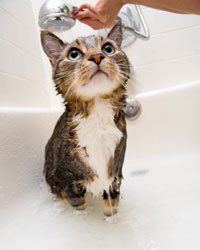Grooming and Bathing
 Cats by nature are very clean. A typical cat spends 5 hours a day grooming herself—and 16 sleeping. But sometimes even the most fastidious feline sometimes needs a makeover.
Cats by nature are very clean. A typical cat spends 5 hours a day grooming herself—and 16 sleeping. But sometimes even the most fastidious feline sometimes needs a makeover.
Here are some of the benefits of regularly grooming your cat:
- Keep your cat’s coat and skin clean and in good condition
- Reduce the amount of hair on your clothes and furniture
- Decrease hairballs
- Help allergy sufferers tolerate your cat better
- Reduce damage and injury from sharp toenails
- Discover health problems (wounds, fleas, ticks, lumps, rashes, weight loss, ingrown toenails, ear infection) before they become serious
- Prevent uncomfortable and unsightly mats
- Spend “quality time” with your cat
How Often?
It depends on the type of coat, and on your cat’s tolerance level. Short and medium-haired cats are generally fine with weekly brushing to remove dead hair and redistribute skin oils. Cats with short hair rarely need to be bathed unless they are unusually dirty or unable to clean themselves due to poor health. Long-haired cats are a different matter. They need to be brushed several times a week or even daily to keep tangles and matting under control. The Persian and Persian-related cats benefit from a daily brush. They also may need to be bathed every month or two to keep the long coat clean. Toenails need trimming every two weeks or so.
Coat Care
Some cats adore being groomed, while for others, it takes some getting used to. For best results, choose a time when both your and your cat are relaxed. Start with short sessions at first and build as you both get more comfortable. Begin by stroking your cat with your hands and then move on to the brush or comb. Be gentle around sensitive areas like the belly, haunches, tail, and ears. Always work in the direction that the fur grows. Praise and reward her for good behavior.
There are many grooming tools on the market, and you may need to experiment to see what works best for you and your cat. See the glossary below if you are not familiar with the types of grooming tools. For long-haired cats, it’s good to start with a wide-toothed or shedding comb. This detangles and removes dead undercoat hairs. Then follow with a slicker brush, curry comb, or grooming glove to smooth the coat and make it shine.
Mats are often a problem in longer haired cats. For isolated mats, grasp the mat at its base and work with a wide toothed comb starting at the tip and working inward toward the base. Avoid the temptation to cut a mat out with scissors! It is easy to cut the skin by mistake. If matting is severe or becomes unmanageable, consult your veterinarian or a professional groomer.
Short-haired cats usually just require a soft brush, followed by a chamois. Some of the delicate-haired cats such as the rex-coated cats only require a light chamois or hand rub.
Note that a flea comb is not just a useful tool for identifying fleas and dirt in the coat—it also works well to remove dead hairs in both short and longer haired cats and can be used to help keep the coat free of debris.
Bathing
If your cat has long hair or gets very dirty, she will need to be bathed—but don’t expect her to like it. Most cats are thoroughly insulted at the prospect of a bath. Some resist vigorously. In fact if your cat is frail, has heart problems, or high blood pressure, check with your veterinarian before heading for the tub.
Here are some tips to make it as painless as possible:
- Try using the kitchen sink, especially if there is a moveable nozzle. Working at waist level gives you better control, and your cat will feel less panicked because she can see over the sides. Try to run water gently over the hair using a stream of water—avoid a spray if this worries the cat.
- Having a helper hold your cat while you lather can make a big difference. Another little trick is to put in an old framed window screen in the tub. Kitty can then grab onto the screen for a secure purchase. This has a calming effect.
- Choose a pet shampoo specifically labeled for use in cats. Avoid flea preparations which are meant for dogs. These are generally unsafe for cats. (If your cat has fleas, consult your veterinarian for safe, effective treatments.) Human shampoo —even baby shampoo—is too harsh for feline skin.
- Have all your supplies; grooming tools, shampoo, towel, washcloth or sponge, cotton balls on hand before you start.
- Give your cat a good combing beforehand. Any mats or tangles will be much easier to remove before the coat gets wet. If mats are wetted, they will tighten down and be much harder to remove.
- Wet down, lather, and then rinse from the neck down, but leave the head dry until the end. Cats hate having their face and ears drenched and will shake suds everywhere. Avoid getting water into the ears. Some place cotton plugs in the ears, but if you do that, make sure you remove them after the bath. Avoid getting soap and water into the eyes. Cats do not like that any more than we do. Hand washing the face with a facecloth will help prevent problems. Rub a damp, slightly soapy washcloth/sponge over the face, eyes, ears, and head in the direction that the hair grows. This should be sufficient to clean these areas. Then rinse thoroughly.
- Make sure no soap is left in the coat anywhere as this will irritate the skin.
- Gently squeeze feet and tail to wring out excess water. Wrap in a thick towel and pat dry. Gently dry the inside of the ears with a cotton ball.
- Some cats tolerate a hair dryer on low speed/medium heat. Keep the airflow moving so as not to burn the skin. Always place your hand between your cats skin and the machine—that way you can monitor the heat. Use that hand to gently rub and fluff the fur as you dry it.
- Avoid new tangles by brushing out thoroughly while the coat is still slightly damp.
Nail Trimming and Ear/Eye Cleaning
This may be a breeze or an ordeal depending on your cat’s temperament. Some act slightly bemused; others despise having their feet touched especially. Set yourself up for success using sharp, good quality cat nail scissors, which can be purchased wherever you buy grooming supplies. Review our article on Nail Trimming for details of the procedure and some examples of trimming equipment.
Ear cleaning rarely needs to be done in cats. If your veterinarian or professional groomer has advised the procedure be done, review our article on Ear Cleaning for details. Some cats with short faces need regular eye cleaning—see this article for tips on how to gently cleanse around the eyes.
Glossary
Curry comb: A brush with rubber bristles that traps dead hair and debris on the surface of the coat.
Grooming glove: A glove with rubber bristles on the palm and fingers that works like a curry comb.
Flea comb: A metal comb with very closely-spaced tines for extracting fleas and flea eggs.
Shedding comb: A metal comb with alternating short and long tines that extract dead undercoat hairs.
Slicker brush: A flat, rectangular brush with short angled wire bristles.
Chamois: A soft cloth made from cow hide—often used for polishing cars.
You May Also Like These Articles:
Cat Fleas: Does My Cat Have Fleas?
How Do I Get My Cat into a Carrier?
Tips for Finding Fleas on Your Cat: VIDEO
Notice: Ask-a-Vet is an affiliated service for those who wish to speak with a veterinary professional about their pet's specific condition. Initially, a bot will ask questions to determine the general nature of your concern. Then, you will be transferred to a human. There is a charge for the service if you choose to connect to a veterinarian. Ask-a-Vet is not manned by the staff or owners of CatHealth.com, and the advice given should not delay or replace a visit to your veterinarian.






